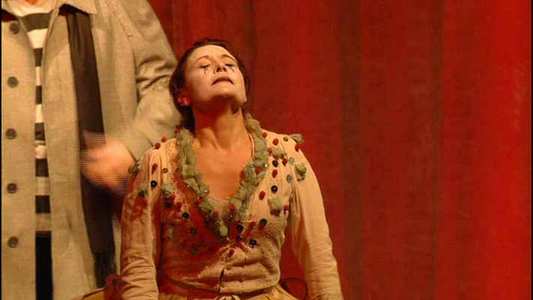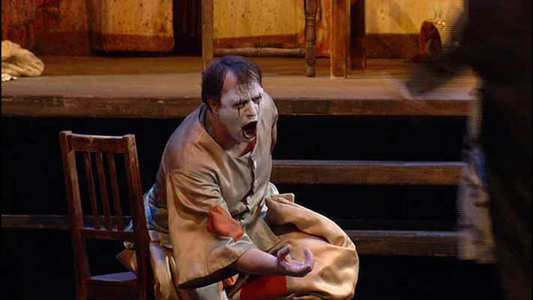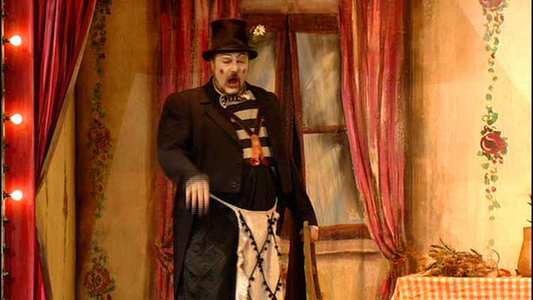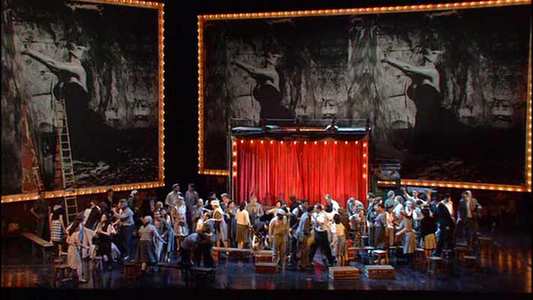Cavalleria Rusticana & Pagliacci (López Cobos)
Introduction
Live performances of Mascagni`s and Leoncavallo`s highly emotive, and hugely popular operas, filmed over two nights in early 2007.
These two works have been performed together for so long, or, according to Giancarlo del Monaco, "sentenced to live together" that it is almost impossible to think or one without the other. The more familiar popular name for the duo of `Cav & Pag` gives the impression they are one work, written by one composer, containing a maelstrom of human emotions, principally love and jealousy, as the two, like these operas, are very rarely seen without each other.
And of course, we have a few juicy murders.
Del Monaco has decided to `merge` the two operas, which is apparently not a new idea. Leoncavallo`s Prologue therefore comes before Mascagni`s work, the words capturing the whole essence of the `verismo` movement, a style of opera which stripped all pretensions away and showed provincial, real-life characters acting out provincial, real-life dramas. As with many other musical styles, the name was forged in literary movements beforehand, and the two operas presented here act as the opening salvo of the verismo style within Italian opera. The Italian verismo movement was expanded further decades later with neo-realist films such as `The Bicycle Thieves` and `Rome, Open City`.

Video
Video quality is excellent throughout, but we have some noticeable camera wobbles, especially during the love scene between Nedda and Sylvio in Pagliacci although this isn`t a problem with the DVD itself.

Audio
Sound is equally impressive, with an excellent balance between stage and pit, and also within the pit itself, with great depth and clarity in the orchestral textures.

Features
The extras consist of some welcome interviews with the conductor, director and each of the principal soloists. These are lengthier than those you are generally used to, and are a worthwhile addition.
We also have a very informative essay from Tom Sutcliffe within the accompanying booklet.

Conclusion
I was intrigued to see how the Prologue to Pagliacci would work as the opening to both the operas, but it seems a very natural thing to do. Carlo Guelfi (Tonio / Taddeo) emerges from the audience and wanders around the front stalls as naturally as someone can do while performing one of the most famous operatic openings ever written. At the very least, this grabs the attention of everyone there (despite a few members of the audience looking a bit awkward). He has a very fine voice and when the camera closes in on a young (and not unattractive) woman singing along to his every word, you know that this is music which has an important place in peoples` lives.
Tonio finishes his Prologue on stage, and arrives in the territory of Cavalleria Rusticana. This is supposed to be set in a rustic (hence the name) Sicilian village around Easter, although del Monaco has stripped away the expected sun-bleached houses and church to several large blocks of white stone, that resemble the Mount Cofano marble quarry on the island. So, a little imagination on our part has to be invoked.
There is little left to the imagination however when it comes to the bleakness of the whole story, and the wonderful music of what is know as the `Easter Hymn` is counterbalanced by a depiction of the Passion moving slowly across the back of the stage, complete with rhythmic self-flagellation.
The singing is almost uniformly excellent, although we have to endure some overacting here and there. I was particularly impressed with Dragana Jugovic`s portrayal of a very dark and sexy Lola, and Violeta Urmana (Santuzza) does a sterling job, in spite of having to play her role as some form of outcast animal who lives in a cave. But then again, perhaps this is how those who were excommunicated were treated in those days.
According to the vocal score I was following (well, it was something to read while the DVD was on), the final fight between Turridu and Alfio, both finely sung by Vincenzo La Scola and Marco di Felice, should have taken place offstage, but we see everything unfold in front of us, which is a shame as it`s a bit of a camp fight to be honest.
And all of a sudden we are into Pagliacci. A little too suddenly in fact, as the applause is cut off in a very unsubtle way, leading into the applause for the second half, leaving us no time to grab a breath before the next opera.
Another none-too-subtle touch del Monaco throws at us, is the sight of Turridu`s body being carried off behind the action on stage. I`m not sure we need more reminders that these two works belong together, and I`m not sure it helps merging the two, quite separate dramas.
With the Prologue already got out of the way we are thrown into a more modern post-war city, yet that is mercifully all del Monaco does to the set.
This is the more successful half of the performance, where the characters appear more human, and willing to give in to the more base human emotions at the drop of a hat.
Vladimir Galouzine (Canio / Payaso) is a particularly strong, dark and quite nasty character, although he has obviously had to get used to his young and pretty wife, Nedda being chased by several other men, and this is perhaps this is why she is `dressed-down` while moving between shows. She is however, obviously a woman with some needs her husband is incapable of satisfying, and María Bayo is in fine voice, coming across as a wife who seems to be in a state of constant sexual arousal. I`m not sure about her choice of lover though, as Sylvio (Ãngel Ódena) doesn`t ooze a lot of macho sexuality himself.
Despite the underlying menace within Canio, you cannot help but sympathise with him, and his `Vesti la giubba` is one of the most moving live performances I`ve seen. This is followed immediately by a very nice cinematic touch during the Intermezzo, where we see, in close-up, each character perparing for the show, each most likely going through the same emotions as Canio himself.
The final `play with a play` is highly successful, both musically and theatrically. The intimacy of the action is cuaght well on camera, and the stage audience themselves are caught in their own play, as the main stage is also lit up as the smaller one on stage.if you see what I mean.
The final scene, although expected, is still shocking, but necessarily so.
López Cobos interprets the music with great skill and you won`t be disappointed even if you are already overly familiar with these works. I wasn`t sure if there hadn`t been any slight transpositions around the sections where the operas `collided`, but even if there were, apart from the awkward, forced `scene change` between operas for the DVD, nothing really appears out of place.
This release deserves a strong recommendation.
Your Opinions and Comments
Be the first to post a comment!